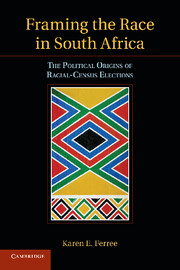Book contents
- Frontmatter
- Contents
- List of Tables
- Acknowledgments
- 1 Introduction
- 2 Voters
- 3 The 1994 Campaigns
- 4 The 1999 Campaigns
- 5 The 2004 Campaigns
- 6 Can a Leopard Change Its Spots? Candidate Demographics and Party Label Change
- 7 Why So Slow? The Political Challenges of Candidate Transformation for Opposition Parties
- 8 Negative Framing Strategies and African Opposition Parties
- 9 Conclusion: South Africa in Comparative Perspective
- References
- Index
- Titles in the series
8 - Negative Framing Strategies and African Opposition Parties
Published online by Cambridge University Press: 06 December 2010
- Frontmatter
- Contents
- List of Tables
- Acknowledgments
- 1 Introduction
- 2 Voters
- 3 The 1994 Campaigns
- 4 The 1999 Campaigns
- 5 The 2004 Campaigns
- 6 Can a Leopard Change Its Spots? Candidate Demographics and Party Label Change
- 7 Why So Slow? The Political Challenges of Candidate Transformation for Opposition Parties
- 8 Negative Framing Strategies and African Opposition Parties
- 9 Conclusion: South Africa in Comparative Perspective
- References
- Index
- Titles in the series
Summary
Thus far in this book I have focused on how the challenges faced by “white” opposition parties in transforming their apartheid-based party images contribute to racial-census elections and single-party dominance in South Africa. While the focus on the white opposition is appropriate when explaining the origins of the racial census in South Africa (after all, it is largely the failure of the white parties to attract African votes that drives this outcome), more is needed for a full explanation of ANC dominance. ANC dominance reflects not only the weakness of white or multiracial parties but also the failure of African opposition parties to mount successful challenges to ANC hegemony. It is therefore useful to consider whether image politics play the same role in weakening African opposition parties as they do for the white opposition. Have African competitors been hampered by problematic images? Has the ANC employed against its African competitors the same framing tactics and strategies that it has used so successfully against the white opposition? In other words, are image politics general to electoral competition in South Africa?
Many African parties in South Africa (the Pan African Congress [PAC], the Azanian Peoples Organization [Azapo], the United Christian Democratic Party [UCDP], and other microparties) lack fund raising capabilities and national branch structures. They are small, winning only a percentage or two of the vote and claiming a few seats in national or provincial legislatures.
- Type
- Chapter
- Information
- Framing the Race in South AfricaThe Political Origins of Racial Census Elections, pp. 193 - 221Publisher: Cambridge University PressPrint publication year: 2010

